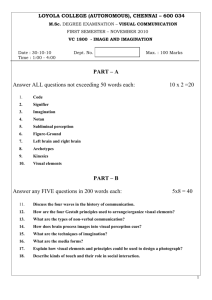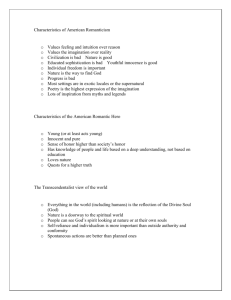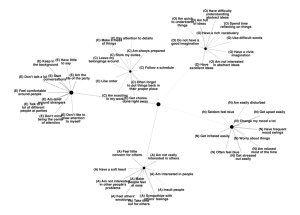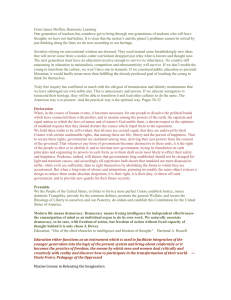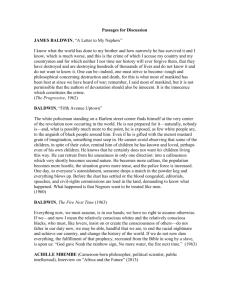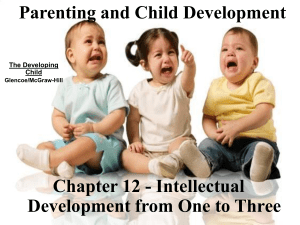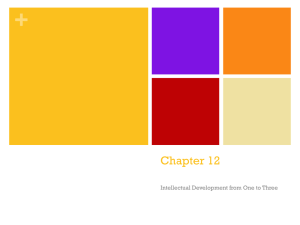Cognitive Development 2 Toddlers Revised
advertisement
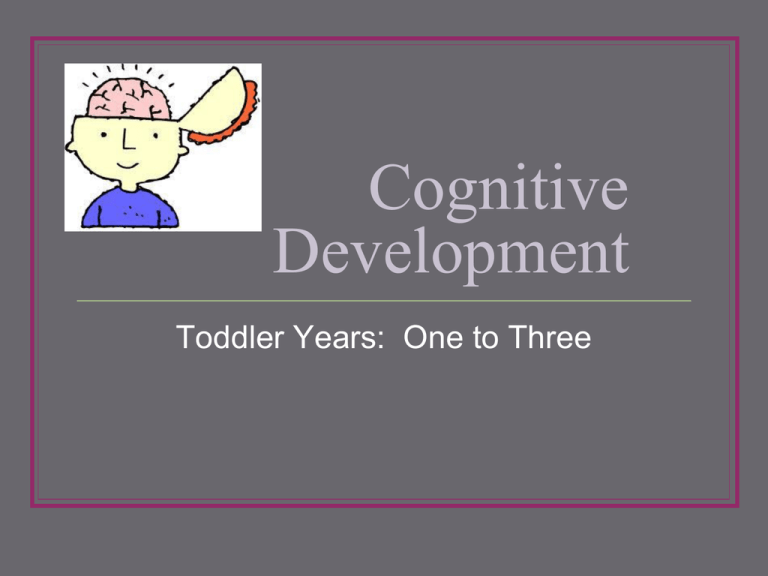
Cognitive Development Toddler Years: One to Three Role of Intelligence INTELLIGENCE: the ability to interpret and understand everyday situations To use prior experience when faced with new situations or problems The capacity to learn We are all born with certain limits of possible intellectual development Heredity AND environment shape intelligence Methods of Learning Four methods used for learning: Incidental - learning is unplanned Trial and Error – tries several solutions before finding one that works Imitation – watching and copying others. Uses the behavior of others as a model Directed Learning – someone teaches you results (usually a parent or care-giver at this age) Concept Development Concepts are the general categories of objects and information Toddlers use broad generalizations that often need to be sorted out Young children often over-apply labels Learn to categorize by color, shape and size Concept Development Relationships between things begin to be recognized Either/Or (“Big vs Little”) is understood as early as 18 months “middle sized” isn’t realized until approx. age 3 Alive vs not alive takes longer to understand Concept Development Concept of time improves during the 2nd and 3rd years Begin to understand what “soon” means Understands the difference between before and after, but don’t understand yesterday, today, and tomorrow Minds at Work Intellectual Activity can be divided into 7 areas: Attention Memory Perception Reasoning Imagination Creativity Curiosity Intellectual Activity: Attention Unable to block out all of the stimulants of the senses around them Results in being easily distracted Toddlers act on those distractions and find it difficult to stay focused on one thing for an extended amount of time As children mature, they develop the ability to ignore the sensory interest Memory Memory is necessary in order to learn Short term memory is brief allows people to accomplish everyday tasks without burdening the brain to store unimportant information indefinitely Long term memory is for more important dates and information data enters short term memory first; if judged to be important enough, it will be stored in long term Intellectual Activity: Memory in Infants and Toddlers Babies begin to demonstrate memory early Recognition of faces and voices Most memory has to do with faces and food Between 6 months and 1 year, babies develop recall memory – ability to remember for longer periods of time, especially things with a strong emotional impact Around 3 years, long term memory begins to be developed. Perception Information learned through the senses Typical children’s questions “Why” and “How Come” help to build a child’s perception Questions can seem endless, but they help children learn Reasoning Necessary to gain the ability to solve problems and make decisions Begin with simple problem solving and develop more sophisticated reasoning skills Need to give children opportunities to explore and make decisions on their own Start with decisions that have two options like choosing between 2 books Begin to gradually make decisions with more substance – like what to wear and what to eat When helping a toddler learn to make decisions, be sure to provide them with options to choose from, rather than yes or no questions Imagination Imagination becomes apparent around age 2 Active imagination enhances learning because it encourages children to try new things and act out a variety of roles Begin using household items to create play situations Imagination can also help to cope with fear and anxieties Important to recognize the difference between imagination and lying. Until age 5, children sometimes have trouble distinguishing between what is real and what is imagined Creativity Imagination is used to produce original ideas Often displayed in a way that others can see – drawings, paintings, story, etc. Can also be an abstract idea like a daydream, rhyme, or song Becomes an asset throughout life Curiosity Helps brain development and learning Main cause for a child to ask “why” or “how” Allows kids to want to try new activities Parents can stifle creativity if they are too overprotective While kids need to be safe, they need to be allowed to explore Readiness to Learn Can only learn a new skill when they are physically and intellectually ready Being pushed to learn things they are not capable of can cognitively harm a child because of feelings of frustration and failure Make sure “helping” isn’t hindering Reading Readiness Though children are not ready to read at this age, they can begin to understand reading and enjoying it Need to learn to enjoy books by being read to at a young age Allow the child to get involved by pointing to pictures, turning pages, and guessing what comes next Allow children to tell stories based on pictures Work on letter recognition Math Readiness Adults need to be conscious of how often math is used and share those opportunities with children Math begins with exploring sizes, shapes, amounts, and proportions Work on number recognition and counting using daily activities Guide Learning Give your time and attention Allow time for thinking and processing Give only as much help as the child needs Demonstrate how to solve problems Keep explanations simple and on the level of the child Encourage children to explore, discover, and draw their own conclusions Evaluating Toys Is the toy safe? Is it well made and durable? Will it be easy to care for? Does it encourage the use of imagination? Is it colorful? Is it easy for the child to handle? Age Appropriate Toys 1-2 years: 2-3 years: Practices motor control – gross and fine Coordination and understanding are improving Desire to imitate and role play 3-4 years: Play becomes more complex Balance and coordination are better Speech Development Speech Pathologists are trained specialists who identify and correct speech issues Issues may be: not understanding what is said, not speaking at all, or speaks very little Speech issues can begin being treated around the age of 3, though sometimes sooner depending on the issue Hearing issues, learning disabilities and mood disorders can all contribute to speech difficulties Speech: Articulation Articulation is the ability to use clear, distinct speech It is common for children to have difficulty with articulation until 3 or 4 Problems usually correct themselves over time If it is not self-corrected, speech therapy may help Speech: Stuttering Stuttering is a more serious speech difficulty Occurs when a person speaks with sporadic repetition or prolonged sounds Different from hesitation or rushing to get a thought out Causes of stuttering are not fully understood Experts recommend not finishing a word or sentence for someone who stutters All children with speech difficulties need to feel encouragement from those around them

